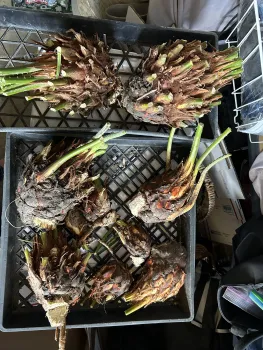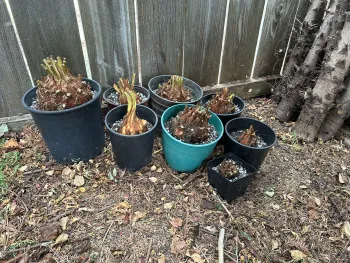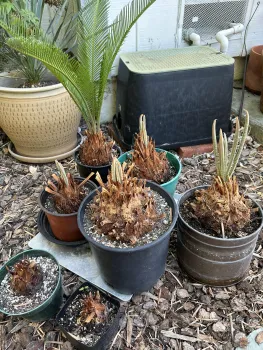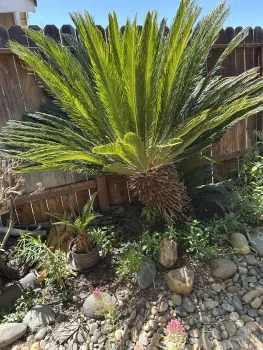The Sago Saga
Blog by Karen Metz
I have had a Sago Palm, Cycas revoluta, for many years. Initially, I had it indoors as a houseplant. It survived , but it didn’t thrive. So, I eventually moved it outdoors and planted it in the ground.
It was much happier there and grew for years. But as it aged, the leaves grew longer and started to encroach on the dry creek bed we had in the side yard. I started pruning “up,” cutting off the lower circle of leaves to make it easier to pass by.
But over the years, the plant also was getting wider. Multiple pups began to appear on the central trunk and at the base. Some of them had their own leaves. I procrastinated because I knew what a big job this was going to be. The lower leaflets had spines, and I had developed a dermatitis working with this plant before.
On June 25, 2024, my husband and I wore our thick gloves and long-sleeved shirts. We spent three hours sawing off sago palm pups. Many of the pups had been damaged during the procedure, but we did end up with eight relatively intact specimens.

Trying to figure out what to do with these pups was challenging. Much of the information on the Internet was conflicting. What we consistently found was to remove any leaves, let the pups callus over, and then pot them up in a pot only slightly larger than the pup. On July 13, 2024, I potted them up in perlite with just a small amount of soil mixed in. It was suggested to keep them in shade and only water when the potting mixture had dried out. The sites had suggested we would have our best chance of survival with the smaller pups. They also mentioned that the entire process would take months, some saying six to nine months.
I checked on one of the small pups in the middle of September 2024. No roots yet. Since we didn’t want the pots to sit in water during our winter rains, we moved them into our garage. They didn’t take up much space. It was easy to periodically check them with the moisture meter to see if they needed watering.

On April 28, 2025, I checked and found that seven of the eight pups had roots, some more than others. At this point, the experts had suggested we increase the percentage of the soil in the planting mix, but still keep them in the smallish pots. We brought the pups with roots outside, but in the shade. By May 20, 2025, one pup had four small leaves. By June 10, 2025, five of the seven pups had at least signs of early leaves. I still had the one pup that had not formed roots.

I called my sister, who, one year ago, had expressed an interest in having a sago palm pup, to see if she still wanted one. I was pleased to find that she did. She promptly potted hers up in a larger pot, and it is doing well.
I will be doing the same with the other pups, as they all get their leaves. The mother plant looks very good and has room to breathe. There are still a few pups attached to her posterior side near the fence, as we couldn’t get back there to remove those. The picture of the mother was taken one year after we had removed the pups.

I do love the tropical look of the Sago Palm. I love knowing that these plants have such an ancient lineage. They are not palms but are, most closely, related to conifers. They need to be given space to grow where people won’t brush against them. They are toxic to people and animals if ingested. If they are grown indoors as houseplants, they grow much more slowly.
The North Carolina Extension Gardener Plant Toolbox at plants.ces.ncsu.edu has wonderful information about growing Sago Palms. There is an excellent article by Lynn McKamey on the Rhapsis Gardens website about propagating the pups. http://rhapsisgardens.com
